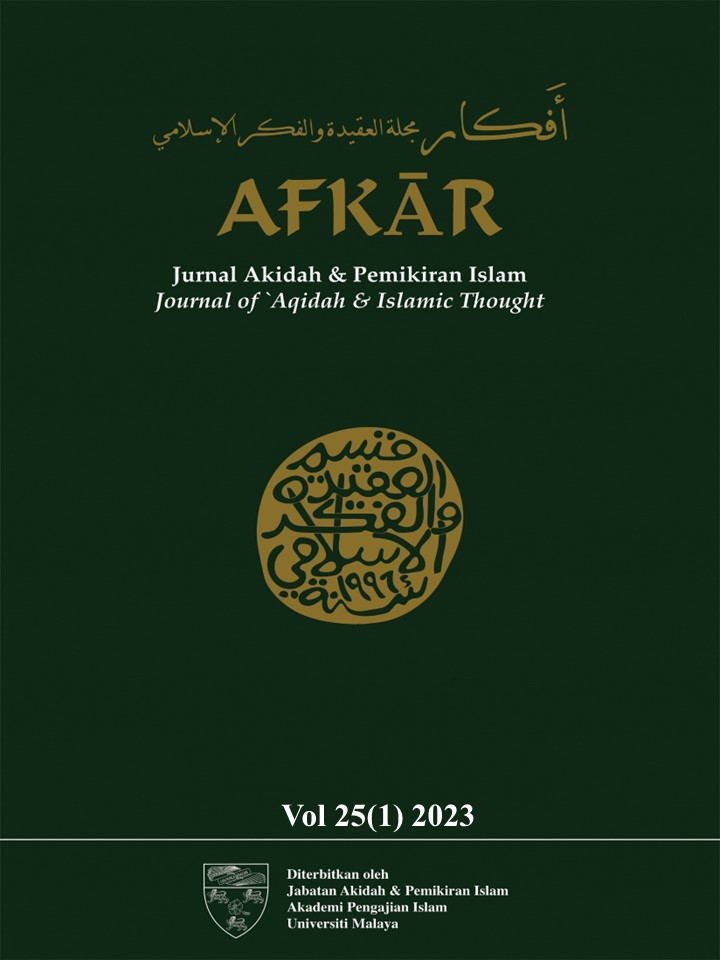Extremist Characteristics Based on Arrested Cases in Southeast Asia
Main Article Content
Abstract
Various aspects such as character, thought, belief, speech, and action were observed to determine the traits of a typical human being. Identifying the characteristics of extremists can be challenging for society, and often only becomes apparent after an individual has been detained as an extremist offender. Religious extremist groups engage in subtle heresy by deviating from the authentic teachings of Islam and promoting these deviations to their adherents as a form of religious reform. This article will examine the transformation of heretics in Southeast Asia by describing extremist characteristics in select countries. This study employed qualitative methods, including content analysis, interviews, and focus group discussions, to investigate the involvement of experts and activists in the process of rehabilitating extremists. Data on the psychological rehabilitation of extremists was gathered and analyzed using authoritative sources such as the Qur’an, Hadith, and works by Muslim and Western scholars, with a focus on references related to Islam, extremism, and heresy. The study aimed to ascertain the attributes of the extremist who was apprehended and subjected to official scrutiny. The results will be applied to extremist traits data and indicators identified by national and international religious extremist researchers, including extremism analysts, university academics, and religious department officials. Consequently, this study can establish a standard indicator for identifying the characteristics of this group, aiding society in detecting and containing its associated movement.
Downloads
Article Details

This work is licensed under a Creative Commons Attribution-NonCommercial 4.0 International License.
References
Abuza, Zachary. Militant Islam in Southeast Asia: Crucible of Terror. Boulder, CO: Lynne Rienner Publishers, 2003. https://www.rienner.com/uploads/47d9901874b3e.pdf
Afroni, Sihabuddin. “Makna Ġuluw dalam Islam: Benih Ekstremisme Beragama.” Wawasan: Jurnal Ilmiah Agama dan Sosial Budaya 1(1) (2016): 70-85. doi: https://doi.org/10.15575/jw.v1i1.579
Ahmad Munawar Ismail et al. “Liberalism, Extremism and Media in the Era of Convergence.” International Journal of Civil Engineering and Technology (IJCIET) 9(10) (2018): 831-840. http://www.iaeme.com/MasterAdmin/Journal_uploads/ijciet/VOLUME_9_ISSUE_10/IJCIET_09_10_085.pdf
Ahmad Munawar Ismail, Wan Kamal Mujani & Ahmad Aiman Zuhaily AM. “Methods of Da’wah and Social Networks in Dealing with Liberalism and Extremism.” Islāmiyyat: The International Journal of Islamic Studies 40(2) (2018): 131-139. doi: https://doi.org/10.17576/islamiyyat-2018-4002-05
Ahmad Sauffiyan Abu Hassan. “Daesh: Kebangkitan dan Pengaruh Media Sosial.” Jurnal Komunikasi: Malaysian Journal of Communication 32(2) (2016): 381-404. https://ejournal.ukm.my/mjc/article/view/16487/7625
Al-Baghdadi, ‘Abd al-Qahir ibn Tahir. Kitab al-Farq bayn al-Firaq wa Bayan al-Firqah al-Najiyah Minhum. Egypt: Matbaʻat al-Maʻarif, 1910.
Al-Hakim, Abu ‘Abd Allah al-Naysaburi. Al-Mustadrak ‘ala al-Sahihayn. Beirut: Dar al-Ma‘rifah, n.d.
Almond, Brenda. “Education for Tolerance: Cultural Difference and Family Values.” The Journal of Moral Education 39(2) (2010): 131-143. doi: https://doi.org/10.1080/03057241003754849
Al-Qaraawi, Yusuf. Islamic Awakening between Rejection and Extremism, translated and edited by A. Al Shaikh Ali. Herndon: International Institute of Islamic Thought, 1991.
Al-Tabari, Abu Ja‘far Muhammad bin Jarir. Jami‘ al-Bayan ‘an Ta’wil ay al-Qur’an. Jakarta: Pustaka Azam, 2007.
Ayob Khan Mydin Pitchay, “Syariah Meja Bulat 2019 | Ep 14 - Jihad.” YouTube TV3MALAYSIA Official, June 25, 2019. Video, 1:00:23. https://www.youtube.com/watch?v=qTwvaSEwXMw
Baqai, Huma. “Extremism and Fundamentalism: Linkages to Terrorism Pakistan’s Perspective.” International Journal of Humanities and Social Science 1(6) (2011): 242-248. http://www.ijhssnet.com/journals/Vol._1_No._6;_June_2011/26.pdf
Davies, Lynn. Education Against Extremism. United Kingdom: Trentham Books, 2008.
Elias, Elias Antoon. Elias’ Modern Dictionary: English-Arabic; Arabic-English. Cairo: Elias’ Modern Press, 1913.
Horgan, John. The Psychology of Terrorism. London: Routledge, 2004.
Ibn Faris, Abu al- Husayn Ahmad. Mu’jam Maqayis al-Lughah. Beirut: Dar al- Fikr, 1979.
INFID (International NGO Forum on Indonesia Development), “Urgensi dan Strategi Efektif Pencegahan Ekstremisme di Indonesia,” accessed August 1, 2019. https://www.infid.org/publication/read/kertas-kebijakan-urgensi-dan-strategi-efektif-pencegahan-ekstremisme-di-indonesia
IYRES (Institute for Youth Research Malaysia), “Garis Panduan Pencegahan Fahaman Radikalisme dan Ekstremisme Dalam Kalangan Belia dan Masyarakat,” Ministry of Youth and Sport, https://www.ippbm.gov.my/dokumen/Garis%20Panduan%20Ekstremisme.pdf
Kamarulnizam Abdullah. “The Rise of Radical Political Islam in Southeast Asia: A Malaysian Perspective.” Paper presented at the International Symposium on the Dynamics and Structure of Terrorist Threats in Southeast Asia, Kuala Lumpur, April 18–20, 2005.
Kamilin Jamilin, “Syariah Meja Bulat 2019 | Ep. 14 – Jihad. YouTube TV3MALAYSIA Official, June 25, 2019. Video, 1:00:23. https://www.youtube.com/watch?v=qTwvaSEwXMw
Kanade, Nikhil. “Tracing Islamic Extremist Ideologies: The Historical Journey of Jihad from the Late Antique Period to the 21st Century.” Senior thesis, Claremont McKenna College, 2016. https://scholarship.claremont.edu/cmc_theses/1389/
Levesque, Roger JR, ed. Encyclopedia of Adolescence. New York: Springer Science & Business Media, 2011.
Maszlee Malik. ISIS. Selangor: PTS Publishing House, 2016.
Mohamad Kamil Abd Majid & Rahimin Affandi Abd Rahim. “Perubahan Sosial dan Impaknya Terhadap Pembentukan Modal Insan Menurut Ibn Khaldun.” Journal of Hadhari 1(1) (2009): 50-51. https://ejournal.ukm.my/jhadhari/article/view/12194/3839
Mohd Faizal Abdul Khir, Ahmad Muhammad Syahid & Mohd Khairul Nizam Zainan Nazri. “Sustaining Tolerance According to Brenda Almond’s “Education for Tolerance”: An Analysis from Islamic Perspective.” International Journal of Humanities and Social Science 8(20) (2015): 46-50. doi: 10.9790/0837-20854650
Mohd Mizan Mohammad Aslam. “Critical Study of Kumpulan Militan Malaysia, Its Wider Connections in the Region and the Implications of Radical Islam for the Stability of Southeast Asia.” PhD diss., Victoria University of Wellington, 2009. https://core.ac.uk/download/pdf/41339479.pdf
Muslim ibn al-Hajjaj al-Qusyairi. Sahih Muslim. Jakarta: Publisher Widjaya, 1966.
Noresah Baharom. Kamus Dewan Edisi Keempat. Kuala Lumpur: Dewan Bahasa dan Pustaka, 2007. https://prpm.dbp.gov.my/Cari1?keyword=extremism&d=28648LIHATSINI
Pavlova, Elena. “Jemaah Islamiah According to PUPJI.” In A Handbook of Terrorism and Insurgency in Southeast Asia, ed.ATH Tan. Cheltenham: Edwar Elgar Publishing Limited, 2007: 76-103.
Shereeza Mohamed Saniff & Noor Shakirah Mat Akhir. “Views of Selected Malaysian Muslims Academia on Extremism in Islam.” Jurnal Akidah & Pemikiran Islam (Afkar) 19 (Special Issue) (2017): 147-194. doi: https://doi.org/10.22452/afkar.sp2017no1.5
Siti Naqiyah Mansor, Salasiah Hanin Hamjah & Izzah Nur Aida Zur Raffar. “Ideologi Gerakan Islamic State of Iraq dan Sham (ISIS) di Malaysia.” ISLAMIYYAT 40(2) (2018): 95-103. https://doi.org/10.17576/islamiyyat-2018-4002-01
Willis, Lauren. Extremism: Opposing Viewpoints. New York: Greenhaven Press, 2011.
Yusoff @ Abdul Hamid Yunus. Penjelasan Terhadap 58 Ciri Ajaran Sesat di Malaysia. Putrajaya: Jabatan Kemajuan Islam Malaysia, 2006.
Zulkifli Mohamad al-Bakri. Ahli Sunnah Wal Jamaah dan Usulnya. Negeri Sembilan: Pustaka Cahaya Kasturi, 2015.

